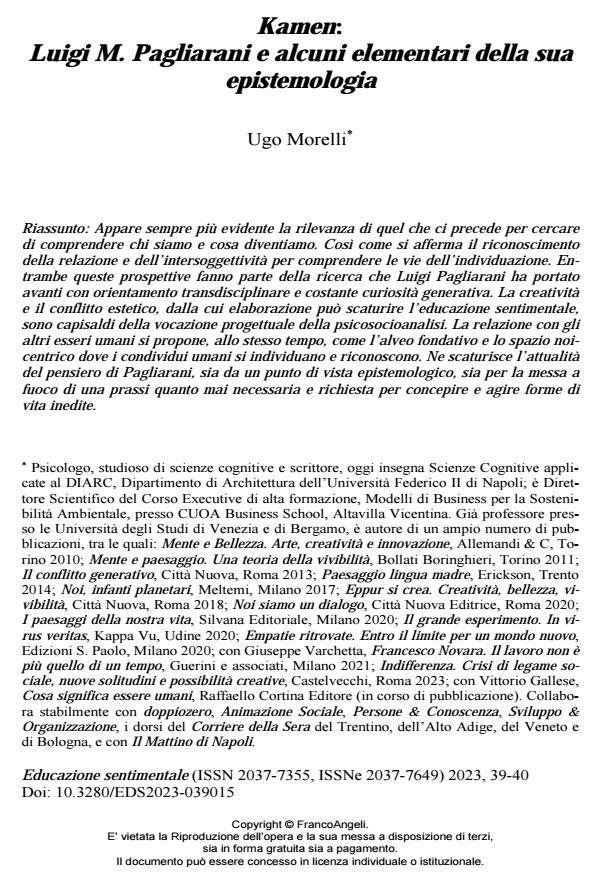Kamen: Luigi M. Pagliarani e alcuni elementari della sua epistemologia
Journal title EDUCAZIONE SENTIMENTALE
Author/s Ugo Morelli
Publishing Year 2024 Issue 2023/39-40
Language Italian Pages 21 P. 195-215 File size 260 KB
DOI 10.3280/EDS2023-039015
DOI is like a bar code for intellectual property: to have more infomation
click here
Below, you can see the article first page
If you want to buy this article in PDF format, you can do it, following the instructions to buy download credits

FrancoAngeli is member of Publishers International Linking Association, Inc (PILA), a not-for-profit association which run the CrossRef service enabling links to and from online scholarly content.
Kamen: Luigi M. Pagliarani and some basics of his epistemology. The relevance of what precedes us in trying to understand who we are and what we become appears in-creasingly evident. Just as the recognition of relationships and intersubjectivity is af-firmed to understand the paths of identification. Both of these perspectives are part of the research that Luigi Pagliarani has carried out with a transdisciplinary orientation and constant generative curiosity. Creativity and aesthetic conflict, from the elaboration of which sentimental education can arise, are cornerstones of the planning vocation of psychosocioanalysis. The relationship with other human beings is proposed, at the same time, as the foundational bed and the us-centric space where human beings identify and recognize each other. The relevance of Pagliarani’s thought arises from this, both from an epistemological point of view and for the focus on a practice that is more necessary and required than ever to conceive and act on new forms of life.
Keywords: puer, origin, antecedent, creativity, action, intersubjectivity, relationship.
- Gallese V. (2001). The shared manifold Hypothesis and the neural basis of intersubjectivity. Journal of Consciousness Studies, 8(5-7).
- Agamben G. (2001). Infanzia e storia. Distruzione dell’esperienza e origine della storia. Torino: Einaudi.
- Ammaniti M., Gallese V. (2014). La nascita della intersoggettività. Lo sviluppo del sé tra psicodinamica e neurobiologia. Milano: Raffaello Cortina Editore.
- Anokhin K.V., Tiunova A.A., Rose S.P.R. (2002). Reminder effects – reconsolidation or retrieval deficit? Pharmacological dissection with protein synthesis inhibitors following reminder for a passive-avoidance task in young chicks. European Journal of Neuroscience, 25 Giugno.
- Dolto F. (1994). Il desiderio femminile. Milano: Mondadori.
- Edelman G.M.(1991). Il presente ricordato. Milano: Rizzoli.
- Freud S. (2008). Lettere a Wilhelm Fliess 1887-1904. Torino: Bollati Boringhieri.
- Friedberg D.A., Gallese V. (2010). Motion, emotion and empathy in aesthetic experience. Trends in Cognitive Sciences, 7.
- Gallese V. (2005). Embodied simulation: from neurons to phenomenal experience. Phenomenology and the Cognitive Sciences, 4.
- Gallese V. (2017). Vision of the body. Embodied simulation and aesthetic experience. Aisthesis, 10(1).
- Harris Williams M., Waddell M. (1996). La stanza del pensiero verginale. Roma: Di Renzo Editore.
- Kandel E.R. (2011). Alla ricerca della memoria. Torino: Codice Edizioni.
- Kandel E.R. (2016). L’età dell’inconscio. Arte, mente e cervello dalla grande Vienna ai nostri giorni. Milano: Raffaello Cortina Editore.
- Mandel’stam O. (2021). Conversazione su Dante. Introduzione di Serena Vitale. Milano: Adelphi.
- Morelli U. (2010). Mente e bellezza. Arte, creatività e innovazione. Torino: Allemandi & C.
- Morelli U. (2018a). Eppur si crea. Creatività, bellezza, vivibilità. Roma: Città Nuova.
- Morelli U. (2018b). Il conflitto generativo. Roma: Città Nuova.
- Morelli U. (2023). Indifferenza. Crisi di legame sociale, nuove solitudini e possibilità creative. Roma: Castelvecchi editore.
- Pagliarani L. (2012). Violenza e bellezza. Il conflitto negli individui e nella società. U. Morelli e C. Weber, a cura di. Milano: Guerini e associati.
- Prodi G. (1977). Le basi materiali della significazione. Milano: Bompiani. Nuova edizione Milano-Udine: Mimesis, 2021.
- Prodi G. (1983). L’uso estetico del linguaggio. Bologna: il Mulino.
- Recalcati M. (2021). Ritorno a Jean-Paul Sartre. Esistenza, infanzia e desiderio. Torino: Einaudi.
- Ronchi R. (2017). Il canone minore. Verso una filosofia della natura. Milano: Feltrinelli.
- Sartre J.P. (1971-1972). L’idiota della famiglia. Gustave Flaubert dal 1821 al 1857. Milano: Il Saggiatore, 2019.
- Simondon G. (1964). L’individuazione delle unità percettive e il significato. Ora in G. Simondon, L’individuazione psichica e collettiva, traduzione di Paolo Virno. Roma: Derive e approdi, 2001.
- Spinoza B. (2006). Etica. G. Agamben, a cura di. Vicenza: Neri Pozza editore.
- Stern D. (2011). Le forme vitali. L’esperienza dinamica in psicologia. Milano: Raffaello Cortina Editore.
- Winnicot D. (1965). Sviluppo affettivo e ambiente: studi sulla teoria dello sviluppo affettivo. Roma: Armando, 1970.
- Wilson E.O. (2018). Le origini della creatività. Milano: Raffaello Cortina Editore.
- Winnicott D. (1971). Gioco e realtà. Roma: Armando, 1974.
- Winnicott D. (1986). Dal luogo delle origini. Milano: Raffaello Cortina Editore, 1990.
- Winnicott D. (1988). Sulla natura umana. Milano: Raffaello Cortina Editore, 1989.
- Winnicott D. (2017). Dalla pediatria alla psicoanalisi. Firenze: Giunti.
- Zambrano M. (1939). Filosofia y poesia. Madrid: Fondo de Cultura Economica, 1996.
- Zanzotto A. (2006). Eterna riabilitazione da un trauma di cui s’ignora la natura. Roma: nottetempo.
Ugo Morelli, Kamen: Luigi M. Pagliarani e alcuni elementari della sua epistemologia in "EDUCAZIONE SENTIMENTALE" 39-40/2023, pp 195-215, DOI: 10.3280/EDS2023-039015